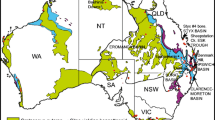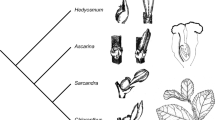Abstract
Fossil chloranthoid androecia,Chloranthistemon endressii gen. et spec. nov. are described from the Upper Cretaceous (Upper Santonian or Lower Campanian) of Scania, southern Sweden. They are three-lobed and dorsiventrally flattened with all pollen sacs borne laterally and inclined toward the presumed adaxial surface. The central lobe bears two pairs of pollen sacs, the lateral lobes a single pair each. The morphology, anatomy and valvate dehiscence of the fossil androecia is very similar to that seen in extant species ofChloranthus andSarcandra, but the in situ pollen differs from that of all extantChloranthaceae in being spiraperturate. A single chloranthoid androecium from the Lower Cretaceous (Upper Albian) of Maryland, North America has a more generalized structure thanChloranthistemon endressii. It consists of three stamens that are fused at the base, and each stamen bears two pairs of oppositely positioned pollen sacs. Combined with anatomical information from recentChloranthus the Lower Cretaceous specimen suggests that the androecium in the living genus has arisen by fusion and other modifications of three separate stamens each with a normal complement of four pollen sacs. The structure of both the Upper and Lower Cretaceous androecia suggest that these fossilChloranthaceae were insectpollinated. Macrofossil evidence combined with information from dispersed pollen indicates that theChloranthaceae diversified early in angiosperm fossil history and were an important component of Mid-Cretaceous plant communities.
Similar content being viewed by others
References
Brenner, G. J., 1963: The spores and pollen of the Potomac Group of Maryland. — Md. Dept. Geol. Mines Water Resour. Bull.27: 1–215.
Burger, W., 1977: ThePiperales and the monocots. Alternate hypotheses for the origin of monocotyledonous flowers. — Bot. Rev. (Lancaster)43: 345–393.
Carlquist, S., 1987: Presence of vessels in wood ofSarcandra (Chloranthaceae): Comments on vessel origins in angiosperms. — Amer. J. Bot.74: 1765–1771.
Couper, R. A., 1958: British Mesozoic microspores and pollen grains. — Palaeontographica Abt. B, Palaeophytol.103: 75–119.
Crane, P. R., 1987: Vegetational consequences of the angiosperm diversification. — InFriis, E. M., Chaloner, W. G., Crane, P. R., (Eds.): The origins of angiosperms and their biological consequences, pp. 107–144. — Cambridge: Cambridge University Press.
—, 1989: Paleobotanical evidence on the early radiation of nonmagnoliid dicotyledons. — Pl. Syst. Evol.162: 165–191.
—, 1984:Lesqueria: An early angiosperm fruiting axis from the Mid-Cretaceous. — Ann. Missouri Bot. Gard.71: 384–402.
—, 1986: Lower Cretaceous angiosperm flowers: fossil evidence of early radiation of Dicotyledons. — Science232: 852–854.
D'Arcy, W. G., Liesner, R. L., 1981:Hedyosmum (Chloranthaceae) in Panama. — Syst. Bot.6: 74–86.
Dettman, M. E., 1973: Angiospermous pollen from Albian to Turonian sediments of eastern Australia. — Geol. Soc. Australia, Spec. Publ.4: 3–34.
Dilcher, D. L., Crane, P. R., 1984:Archaeanthus: an early angiosperm from the Cenomanian of the Western Interior of North America. — Ann. Missouri Bot. Gard.71: 351–383.
Doyle, J. A., 1969: Cretaceous angiosperm pollen of the Atlantic coastal plain and its evolutionary significance. — J. Arnold Arbor.50: 1–35.
—, 1976: Pollen and leaves from the mid-Cretaceous Potomac Group and their bearing on early angiosperm evolution. — InBeck, C. B., (Ed.): Origin and early evolution of angiosperms, pp. 139–206. — New York: Columbia University Press.
—, 1977: Angiosperm pollen zonation of the continental Cretaceous of the Atlantic Coastal Plain and its application to deep wells in the Salisbury Embayment. — Palynology1: 43–78.
Endress, P. K., 1986a: Reproductive structures and phylogenetic significance of extant primitive angiosperms. — Pl. Syst. Evol.152: 1–28.
—, 1986b: Floral structure, systematics, and phylogeny inTrochodendrales. — Ann. Missouri Bot. Gard.73: 297–324.
—, 1987: TheChloranthaceae: reproductive structures and phylogenetic position. — Bot. Jahrb. Syst.109: 153–226.
Friis, E. M., 1984: Preliminary report of Upper Cretaceous angiosperm reproductive organs from Sweden. — Ann. Missouri Bot. Gard.71: 403–418.
—, 1985: Structure and function in Late Cretaceous angiosperm flowers. — Biol. Skr.25: 1–37.
—, 1986: Floral evidence for Cretaceous chloranthoid angiosperms. — Nature320: 163–164.
—, 1987: Time of appearance of floral features. — InFriis, E. M., Chaloner, W. G., Crane, P. R., (Eds.): The origins of angiosperms and their biological consequences, pp. 145–179. — Cambridge: Cambridge University Press.
—, 1982:Scandianthus gen. nov., angiosperm flowers of saxifragalean affinity from the Upper Cretaceous of southern Sweden. — Ann. Bot.50: 569–583.
Furness, C. A., 1986: A review of spiraperaturate pollen. — Pollen & Spores27: 307–319.
Hedlund, R. W., Norris, G., 1968: Spores and pollen grains from Fredericksburgian (Albian) strata, Marshall County, Oklahoma. — Pollen & Spores10: 129–159.
Hickey, L. J., 1984: Part 1, Northeast of Washington, D.C., to Brooke, Virginia. — InFredericksen, N. O., Krafft, K., (Eds.): Cretaceous and Tertiary stratigraphy, paleontology and structure, South Western Maryland and Northeastern Virginia, pp. 193–209. — Reston, U.S. Geol. Surv.
—, 1977: Early Cretaceous fossil evidence for angiosperm evolution. — Bot. Rev. (Lancaster)43: 2–104.
Hughes, N. F., Drewry, C. E., Laing, J. F., 1979: Barremian earliest angiosperm pollen. — Palaeontol.22: 513–535.
—, 1987: Records of angiospermid pollen entry into the English Early Cretaceous succession. — Rev. Palaeobot. Palynol.50: 255–272.
Jérémie, J., 1980: Notes sur le genreAscarina (Chloranthaceae) en Nouvelle-Calédonie et à Madagascar. — Adansonia, ser. 2,20: 273–285.
Kemp, E. M., 1968: Probable angiosperm pollen from British Barremian to Albian strata. — Palaeontology11: 421–434.
Kuprianova, L. A., 1981: Palynological data on the familyChloranthaceae, its relationships and the history of distribution. — Bot. Ž. (Moscow, Leningrad)66: 3–15.
Maekawa, F., 1970: Notes on the stamens ofChloranthus japonicus. — J. Japan. Bot.45: 289–294.
—, 1971: Further notes on the stamens ofChloranthus japonicus. — J. Japan. Bot.46: 198.
Mildenhall, D. C., 1978:Cranwellia costata n. sp. andPadosporites erugatus n. sp. from middle Pliocene (?early Pleistocene) sediments, South Island, New Zealand. — J. Roy. Soc. New Zealand8: 253–274.
Mörner, N. A., 1983: The Santonian/Campanian boundary; Palaeomagnetism, sea level changes, biostratigraphy and sedimentology in SE. Sweden. — Subcommission on Cretaceous stratigraphy, symposium on Cretaceous stage boundaries. Abstr. 128–131.
Muller, J., 1981: Fossil pollen records of extant angiosperms. — Bot. Rev. (Lancaster)47: 1–142.
Smith, A. C., 1976: Studies of Pacific island plants, 33. The genusAscarina (Chloranthaceae) in the Southern Pacific. — J. Arnold Arbor.57: 405–425.
Swamy, B. G. L., 1953a: The morphology and relationships of theChloranthaceae. — J. Arnold Arbor.34: 375–411.
—, 1953b: A taxonomic revision of the genusAscarina Forst. — Proc. Natl. Inst. Sci. India19: 371–388.
—, 1950:Sarcandra a vesselless genus of theChloranthaceae. — J. Arnold Arbor.31: 117–129.
Upchurch, G. R., 1984a: Cuticle evolution in Early Cretaceous angiosperms from the Potomac Group of Virginia and Maryland. — Ann. Missouri Bot. Gard.71: 522–550.
—, 1984b: Cuticular anatomy of angiosperm leaves from the Lower Cretaceous Potomac Group. — Amer. J. Bot.71: 192–202.
Van Campo, M., 1976: Patterns of pollen morphological variation within taxa. — InFerguson, J. K., Muller, J., (Eds.): The evolutionary significance of the exine, pp. 125–138. — London: Academic Press.
Verdecourt, B., 1986:Chloranthaceae. — InSteenis, C. G. G. J. van, (Ed.): Flora Malesiana, Ser. 1,10 (2), pp. 123–144. — Dordrecht: Nijhoff.
Walker, J. W., Walker, A. G., 1984: Ultrastructure of Lower Cretaceous angiosperm pollen and the origin and early evolution of flowering plants. — Ann. Missouri Bot. Gard.71: 464–521.
—, 1983: Winteraceous pollen in the Lower Cretaceous of Israel: early evidence of a magnolialean angiosperm family. — Science220: 1273–1275.
Author information
Authors and Affiliations
Rights and permissions
About this article
Cite this article
Crane, P.R., Friis, E.M. & Pedersen, K.R. Reproductive structure and function in CretaceousChloranthaceae . Pl Syst Evol 165, 211–226 (1989). https://doi.org/10.1007/BF00936003
Received:
Issue Date:
DOI: https://doi.org/10.1007/BF00936003




